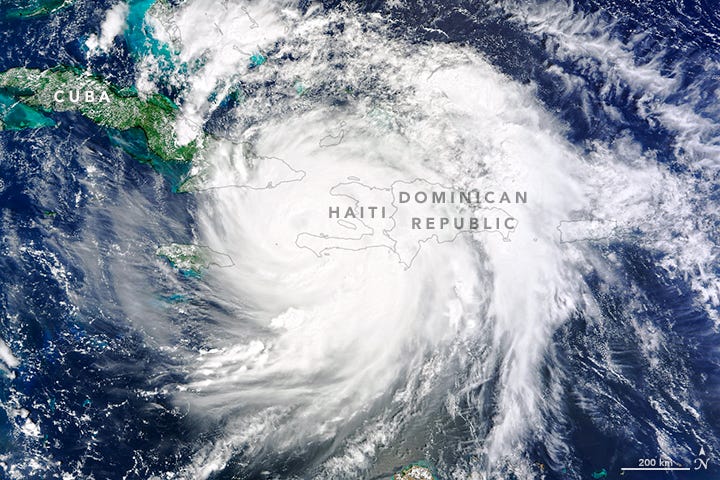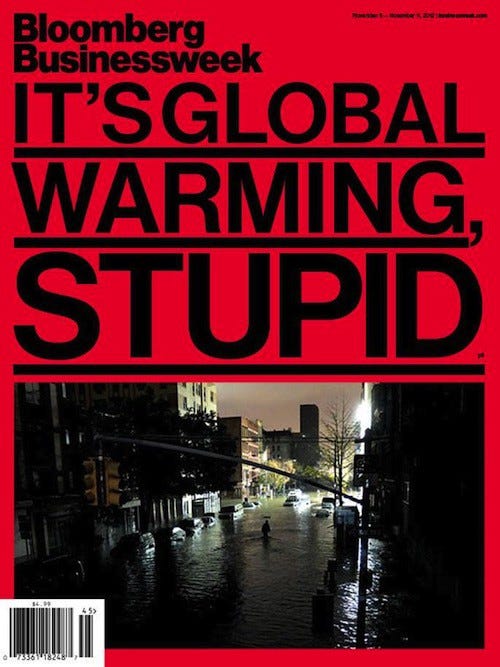
Hurricane Matthew, October 4 (via NASA)
“Category 4 and 5 hurricanes could double or triple in the coming decades,” expert warns...
Hurricane Matthew is slowly approaching the East Coast where it is expected to wreak havoc with storm surge, wind, and rain. Matthew has already set a number of records — and global warming is giving it a boost.
Hurricanes “extract heat energy from the ocean to convert it to the power of wind, and the warmer the ocean is, the stronger a hurricane can get if all other conditions that it needs to exist are present,” meteorologist and former hurricane hunter Jeff Masters explained last month on Living on Earth. “So, scientists are confident that as we continue to heat up the oceans, we’re going to see more of these high-end perfect storms.”
Case in point, as meteorologist Philip Klotzbach has noted:
- Matthew set a new record as the longest lived Category 4 (or higher) Atlantic hurricane in October — 84 hours.
- By Monday, it had already “generated the most accumulated cyclone energy” of any Atlantic hurricane ever recorded in the eastern Caribbean.
- As a result, the 2016 hurricane season has “already generated the most accumulated cyclone energy in the Atlantic in October since 2005” (the year of Katrina, Rita, and Wilma).
Let’s look at some of the latest climate science. One 2013 paper found that “since 1975 there has been a substantial and observable regional and global increase in the proportion of Category 4–5 hurricanes of 25–30 percent per °C of anthropogenic global warming.” Another 2013 paper concluded that “dramatic changes in the frequency distribution of lifetime maximum intensity (LMI) have occurred in the North Atlantic,” and the stronger hurricanes “have become more intense.”
In other words, warming oceans create stronger hurricanes, like the one we’re seeing now.
Matthew spun up from a tropical storm to a Category 5 superstorm in an alarming 36 hours. The latest research says this is also a result of global warming. “Storms are intensifying at a much more rapid pace than they used to 25 years back,” explained the author of a 2012 study. “They are getting stronger more quickly and also [to a] higher category. The intensity as well as the rate of intensity is increasing.”
A 2015 study, “A climatological study of the effect of sea-surface temperature on North Atlantic hurricane intensification,” found a statistically significant relationship between higher intensification values and higher sea surface temperature [SST] values. “On average, mean intensification increases by 16 percent for every 1°C increase in mean SST.”
This warming-driven trend toward more rapid intensification [RI] is very worrisome. “The vast majority (79 percent) of major storms are RI storms,” and “the most intense storms are those that undergo RI,” according to a 2016 study.
The latest storm tracks for superstorm Matthew have it threatening the southeast coast.

Global warming makes all of these dangerous impacts more destructive for superstorms like Sandy and Matthew. For instance, as leading climatologist Kevin Trenberth has explained, “Owing to higher SSTs from human activities, the increased water vapor in the atmosphere leads to 5 to 10 percent more rainfall and increases the risk of flooding.” He elaborates on that here.
More concerning is that warming-driven sea level rise makes storm surges more destructive. A 2012 study found that “the 600-mile stretch of coastline from North Carolina to Massachusetts is experiencing [sea level rise] rates that are nearly three to four times higher than the global average, a trend that may continue during the coming decades.”
Another 2012 study found that landfalling hurricanes cause the biggest storm surges, that hurricanes with the biggest storm surges caused the most destruction, and that Katrina-sized surges “have been twice as frequent in warm years compared with cold years.”
A 2013 paper, “Projected Atlantic Hurricane Surge Threat from Rising Temperatures,” found that the most extreme storm surge events “are especially sensitive to temperature changes, and we estimate a doubling of Katrina-magnitude events associated with the warming over the 20th century.” The study concludes, “We have probably crossed the threshold where Katrina magnitude hurricane surges are more likely caused by global warming than not.”

Bloomberg Businessweek cover story Sandy’s many links to global warming
While we aren’t seeing more total hurricanes, we are seeing more of the Category 4 or 5 super-hurricanes, the ones that historically have done the most damage and destroyed entire coastal cities. We’re also seeing a sharp rise in the most damaging storm surges, whereby even a Category 1 hurricane (such as Sandy) can cause unprecedented damage.
On our current path of unrestricted carbon pollution, NOAA researchers have determined that parts of the East Coast would see Sandy-level storm surges every year by mid-century. One tropical cyclone expert just warned, “Category 4 and 5 hurricanes could double or triple in the coming decades.”
We simply cannot cut carbon pollution fast enough.
Dr. Joe Romm is Founding Editor of Climate Progress
source: https://thinkprogress.org/
original story HERE
Get more of The Global Warming Blog. Bookmark this page and sign up for the blog’s free RSS Feed. Sign up for free Global Warming Blog by clicking here. You will automatically be emailed a regular summary of the latest global warming headlines.
To help do something about the climate change and global warming emergency, click here.
Sign up for our free Global Warming Blog by clicking here. (In your email, you will receive critical news, research, and the warning signs for the next global warming disaster.)
To share this blog post: Go to the Share button to the left below.

Be the first to comment
Sign in with